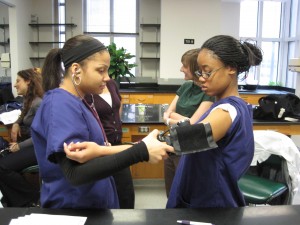 The FDA recently issued the following communication report: Patients and healthcare professionals may have questions about oral bisphosphonate medications and atypical subtrochanteric femur fractures – fractures in the bone just below the hip joint. Oral bisphosphonates are commonly prescribed to prevent or treat osteoporosis in postmenopausal women. Common brand names of medications in this class include Fosamax, Actonel, Boniva, and Reclast. Recent news reports have raised the question about whether there is an increased risk of this type of fracture in patients with osteoporosis using these medications. At this point, the data that FDA has reviewed have not shown a clear connection between bisphosphonate use and a risk of atypical subtrochanteric femur fractures. FDA is working closely with outside experts, including members of the recently convened American Society of Bone and Mineral Research Subtrochanteric Femoral Fracture Task Force, to gather additional information that may provide more insight into this issue.
The FDA recently issued the following communication report: Patients and healthcare professionals may have questions about oral bisphosphonate medications and atypical subtrochanteric femur fractures – fractures in the bone just below the hip joint. Oral bisphosphonates are commonly prescribed to prevent or treat osteoporosis in postmenopausal women. Common brand names of medications in this class include Fosamax, Actonel, Boniva, and Reclast. Recent news reports have raised the question about whether there is an increased risk of this type of fracture in patients with osteoporosis using these medications. At this point, the data that FDA has reviewed have not shown a clear connection between bisphosphonate use and a risk of atypical subtrochanteric femur fractures. FDA is working closely with outside experts, including members of the recently convened American Society of Bone and Mineral Research Subtrochanteric Femoral Fracture Task Force, to gather additional information that may provide more insight into this issue.
Based on published case reports of atypical subtrochanteric femur fractures occurring in women with osteoporosis using bisphosphonates, FDA, in June 2008, requested information from all bisphosphonate drug manufacturers regarding this potential safety signal. All available case reports and clinical trial data were requested. FDA's review of these data did not show an increase in this risk in women using these medications.
In addition, FDA reviewed a December 2008 article in the Journal of Bone and Mineral Research by Abrahamsen et al1, that analyzed data from two large observational studies in patients with osteoporosis. The authors concluded that atypical subtrochanteric femur fractures had many similar features in common with classical osteoporotic hip fractures, including patient age, gender, and trauma mechanism. The data showed that patients taking bisphosphonates and those not taking bisphosphonates had similar numbers of atypical subtrochanteric femur fractures relative to classical osteoporotic hip fractures.
The FDA will continue to review new information as it becomes available and will update the public once the agency's review is complete.
Healthcare professionals should continue to follow the recommendations in the drug label when prescribing oral bisphosphonates. Patients should not stop taking their medication unless told to do so by their healthcare professional. Patients should talk to their healthcare professional about any concerns they have with these medications.
Additional Information for Patients
If you currently take an oral bisphosphonate you should:
* Not stop taking your medication unless told to do so by your healthcare professional.
* Talk to your healthcare professional if you develop new hip or thigh pain or have any concerns with your medications.
* Report any side effects with your bisphosphonate medication to FDA's MedWatch program.
Additional Information for Healthcare Professionals
FDA recommends that healthcare professionals should:
* Be aware of the possible risk of atypical subtrochanteric femur fractures in patients taking oral bisphosphonates.
* Continue to follow the recommendations in the drug label when prescribing oral bisphosphonates.
* Discuss with patients the known benefits and potential risks with using oral bisphosphonates.
* Report any adverse events with the use of oral bisphosphonates to FDA's MedWatch program.
References:
1. Abrahamsen B., Eiken P., Eastell R. Subtrochanteric and Diaphyseal Femur Fractures in Patients Treated With Alendronate: A Register-Based National Cohort Study. J Bone Miner Res. 2009 Jun;24(6):1095-102.



 The Agency for Healthcare Research and Quality issued its 2009 National Healthcare Quality Report and National Healthcare Disparities Report on April 13. The 2009 reports include a new section on lifestyle modifications because preventing or reducing obesity is a crucial national goal. The reports found:
The Agency for Healthcare Research and Quality issued its 2009 National Healthcare Quality Report and National Healthcare Disparities Report on April 13. The 2009 reports include a new section on lifestyle modifications because preventing or reducing obesity is a crucial national goal. The reports found: In celebration of National Women's Health Week, the Institute for Women's Health Research at Northwestern University is hosting an evening of laughter, good cheer and networking. It will be held on May 12, 2010 at 6 pm at the Chicago Center for the Performing Arts and featuring well know Chicago comedienne Patti Vasquez. To view an invitation,
In celebration of National Women's Health Week, the Institute for Women's Health Research at Northwestern University is hosting an evening of laughter, good cheer and networking. It will be held on May 12, 2010 at 6 pm at the Chicago Center for the Performing Arts and featuring well know Chicago comedienne Patti Vasquez. To view an invitation, 
 In recognition of Poison Prevention Week (March 14-20), the Center for Disease Control (CDC) is highlighting the growing issue of unintentional drug poisoning in the United States. More than 26,000 deaths from unintentional drug poisoning occurred in the U.S. in 2006. Opioid pain medications (e.g., oxycodones and methadone) were involved in more than half of these deaths. In recent years, this cause of death has more than doubled between 1999 and 2006. In 2006, 17,740 drug overdose deaths occurred among males and 8,660 among females. Male rates exceed females rates in every age group. However, male rates have doubled and female rates have nearly tripled since 1999. In response to this growing problem the CDC has developed an issue brief titled
In recognition of Poison Prevention Week (March 14-20), the Center for Disease Control (CDC) is highlighting the growing issue of unintentional drug poisoning in the United States. More than 26,000 deaths from unintentional drug poisoning occurred in the U.S. in 2006. Opioid pain medications (e.g., oxycodones and methadone) were involved in more than half of these deaths. In recent years, this cause of death has more than doubled between 1999 and 2006. In 2006, 17,740 drug overdose deaths occurred among males and 8,660 among females. Male rates exceed females rates in every age group. However, male rates have doubled and female rates have nearly tripled since 1999. In response to this growing problem the CDC has developed an issue brief titled 

 The FDA recently issued the following communication report: Patients and healthcare professionals may have questions about oral bisphosphonate medications and atypical subtrochanteric femur fractures – fractures in the bone just below the hip joint. Oral bisphosphonates are commonly prescribed to prevent or treat osteoporosis in postmenopausal women. Common brand names of medications in this class include Fosamax, Actonel, Boniva, and Reclast. Recent news reports have raised the question about whether there is an increased risk of this type of fracture in patients with osteoporosis using these medications. At this point, the data that FDA has reviewed have not shown a clear connection between bisphosphonate use and a risk of atypical subtrochanteric femur fractures. FDA is working closely with outside experts, including members of the recently convened American Society of Bone and Mineral Research Subtrochanteric Femoral Fracture Task Force, to gather additional information that may provide more insight into this issue.
The FDA recently issued the following communication report: Patients and healthcare professionals may have questions about oral bisphosphonate medications and atypical subtrochanteric femur fractures – fractures in the bone just below the hip joint. Oral bisphosphonates are commonly prescribed to prevent or treat osteoporosis in postmenopausal women. Common brand names of medications in this class include Fosamax, Actonel, Boniva, and Reclast. Recent news reports have raised the question about whether there is an increased risk of this type of fracture in patients with osteoporosis using these medications. At this point, the data that FDA has reviewed have not shown a clear connection between bisphosphonate use and a risk of atypical subtrochanteric femur fractures. FDA is working closely with outside experts, including members of the recently convened American Society of Bone and Mineral Research Subtrochanteric Femoral Fracture Task Force, to gather additional information that may provide more insight into this issue.